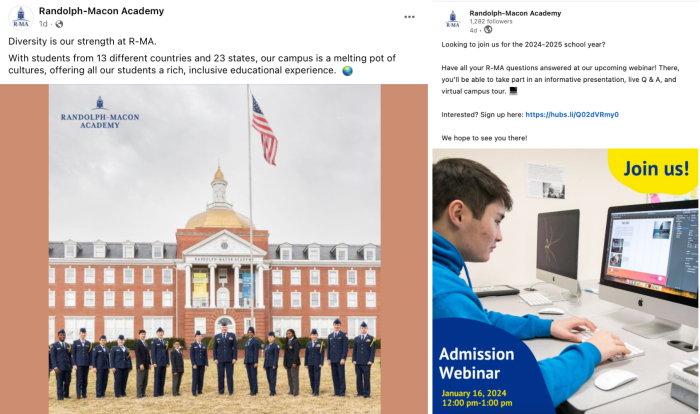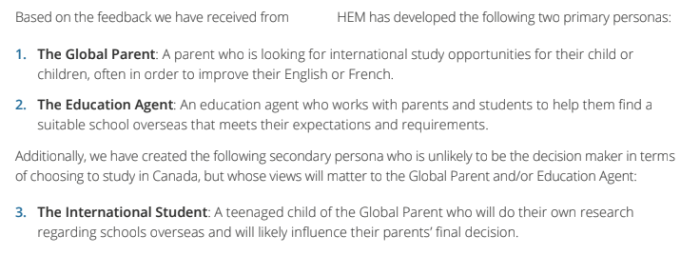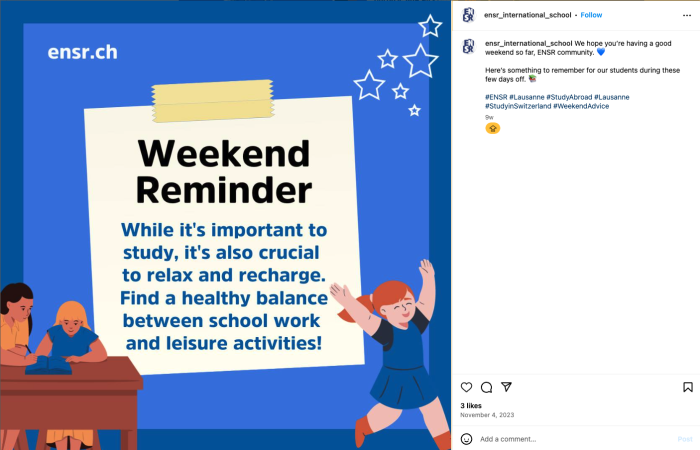K-12 education rapidly evolves in today’s fast-paced world, with digital platforms becoming increasingly integral to school enrollment processes. The advancement of technology, coupled with the changing preferences of students and parents, has made digital marketing a key talking point within the education industry. But how important is digital marketing for student education? Digital marketing enhances a school’s visibility and plays a crucial role in helping students discover better opportunities and find the school that best aligns with their educational needs and aspirations. Thus, developing robust school digital enrollment strategies can help schools connect with students and families where they spend significant time (online) and adapt to the ever-changing preferences of a digitally savvy generation.
In the wake of the pandemic, the role of digital marketing has been further magnified, underlining the necessity of a robust digital presence for schools to remain competitive and relevant. This comprehensive guide delves into digital marketing for schools, highlighting effective school digital enrollment strategies, current trends, and the vital importance of crafting successful digital enrollment strategies.
Demystifying Digital Marketing for Schools
A common question at HEM is, “What is digital marketing for schools?” Digital marketing in the realm of education transcends the boundaries of traditional advertising, offering a multifaceted approach that leverages online platforms and tools. This strategy is not just about promoting school programs; it’s about building meaningful relationships with prospective students and parents. From search engine optimization (SEO) to content marketing and personalized email campaigns, digital marketing encompasses a broad spectrum of tactics designed to support online recruitment for schools and forge a robust digital presence. Schools with robust digital enrollment campaigns tend to coordinate their digital efforts across various platforms and departments, ensuring a cohesive and unified strategy that effectively reaches and engages their target audience.

Techniques for Effective School Enrollment Marketing
Success in the digital age requires a nuanced understanding of various marketing techniques. If you’ve started the new year to improve your digital enrollment strategy, you might have come to this blog wondering, “What techniques can make your school enrollment marketing plan more effective?” Successful schools attract audiences with targeted social media, strong SEO, engaging content, and direct outreach to potential students via personalized email marketing. Additionally, virtual tours and interactive digital experiences have emerged as innovative methods to showcase the unique attributes of a school’s environment and culture.
Example: Schools like Randolph-Macon Academy implement a cross-platform strategy to target their audience better.

Source: Randolph-Macon Academy
Expanding on these, other innovative and helpful techniques may include:
Student ambassador program
Collaborate with student influencers or ambassadors who can authentically share their experiences and promote your school to their followers. In the case of K-12 schools, this could involve working with older students, such as high school juniors and seniors, who can speak to their positive experiences and the opportunities the school has provided, resonating with younger students and their parents.
Data-driven personalization
Utilizing data analytics in digital marketing allows for customizing messages and content to align with the diverse interests, behaviors, and needs of different audience segments. Schools can create targeted marketing campaigns that resonate more effectively with parents and students by analyzing user interactions, preferences, and demographics. This approach ensures that the content is relevant and engaging, enhancing the chances of connecting with potential students and their families on a more personal and meaningful level. It’s a strategy that not only increases the effectiveness of marketing efforts but also demonstrates a school’s commitment to understanding and meeting the needs of its community.
Mobile Optimization
Optimizing all digital marketing content for mobile devices is essential in today’s mobile-first world. Most users access the internet via smartphones, making it crucial for K-12 schools to ensure that their websites, emails, and other digital content are mobile-friendly. This includes a responsive design that adapts to screen sizes, fast loading times, and easy-to-navigate interfaces. Mobile optimization enhances user experience, increases engagement, and improves the effectiveness of your digital marketing efforts, ensuring that prospective students and parents can access and interact with your school’s content anytime, anywhere.
Video Marketing
Creating engaging video content is a powerful way to bring the essence of your school to life for prospective students and parents. Student testimonials can offer authentic insights into the student experience, helping viewers connect emotionally with your school. Day-in-the-life videos provide a realistic and relatable snapshot of everyday activities, giving a taste of the school’s environment and culture. Immersive 360-degree campus tours are particularly effective as they allow prospective families to explore the school’s facilities and atmosphere virtually, creating a sense of presence and engagement. These varied forms of video content work together to create a comprehensive, dynamic portrayal of school life, showcasing the unique aspects of your educational environment and community.
For example, by showcasing a series of videos from the Nueva Social Impact Filmmaking Club, The Nueva School gives a glimpse into student life and highlights the remarkable talents nurtured within its student-led filmmaking club.

Source: The Nueva School
Blogs and articles
Developing a blog series is an effective way to engage your school’s community and provide valuable insights. This series can cover various educational topics, highlight student achievements, and offer a deeper understanding of your K-12 school’s programs. Such content informs and showcases your school’s strengths and unique aspects, serving as an excellent tool for digital marketing. As seen in the example below, you can use these blogs to demonstrate your school’s expertise, supportive and enriching environment, and commitment to student success, making your school more appealing to prospective students and their families.

Source: Randolph-Macon Academy
When effectively implemented, these innovative techniques can significantly enhance a school’s digital enrollment strategy, making it more engaging, dynamic, and appealing to a wide range of prospective students and their families.
Crafting a Successful School Digital Enrollment Strategies
To craft a winning enrollment strategy, we must ask ourselves, “What is the enrollment marketing strategy?” A well-crafted enrollment marketing strategy involves identifying your target audience, setting measurable objectives, selecting the most effective digital channels, and continuously monitoring and adjusting the approach based on data-driven insights.
Since younger generations are increasingly increasingly digital-oriented, K-12 schools should prioritize implementing one. This strategy should have a clear identification of the target audience. Your school will likely have more than one target persona, so to create content and ads that resonate with your potential students and parents, you need to begin asking yourself who the students and families you’re trying to reach are. Understanding their needs, preferences, and online behaviors is crucial for tailoring your message effectively.
For instance, as seen in the example below, your school might have to target parents and educational agents. Given that these two personas are very different, you might have to craft content that provides general information that appeals to what the two personas are looking for.

Setting measurable objectives is the next critical step. These objectives range from increasing enrollment numbers to enhancing engagement with specific community groups. Clear, quantifiable goals allow schools to track progress and measure the success of their digital campaigns.
Choosing the most effective digital channels is where the strategy comes to life, these will be where your digital tactics for student enrollment will be deployed. This could involve leveraging social media platforms for broader reach, email marketing for personalized communication, or creating engaging content on your website and blog to draw in prospective families. It’s about finding the right channel mix that resonates with your audience. However, a successful strategy doesn’t end with implementation. It requires continuous monitoring and adjustment based on data-driven insights. Analyzing engagement metrics, website traffic, and conversion rates can provide valuable feedback, enabling schools to refine their approach and tactics for better results.
Finally, at the heart of a successful digital enrollment strategy lies the concept of digital equity. Your marketing efforts must be inclusive and accessible, irrespective of technological limitations or socioeconomic backgrounds. This means creating accessible content on various devices, considering language diversity in your communications, and ensuring that your digital platforms are user-friendly and navigable for everyone. For K-12 schools, digital equity also extends to portraying the school environment and culture. Showcasing a diverse and inclusive community where every student can thrive is essential. This reflects positively on the school’s values and resonates with a broader audience, fostering a sense of belonging and community.
Navigating Current Trends and Challenges
We all know that the educational landscape is not static but continuously evolving, presenting new opportunities and hurdles. Staying abreast of the latest trends and challenges is crucial for schools aiming to optimize their digital enrollment strategies and K-12 online marketing. Here are some of the current trends and challenges your K-12 school might need to consider this year:
AI in Education
A key development has been the integration of artificial intelligence (AI) in education. AI is revolutionizing personalized learning experiences, offering students tailored educational pathways and support systems. Regarding AI’s application in education marketing, its impact is becoming increasingly pivotal. AI-powered tools, such as chatbots for instant communication and language processing for content creation, are revolutionizing how schools interact with prospective students. These tools contribute to more efficient lead generation and help craft marketing strategies more aligned with student needs and preferences. However, integrating AI in education marketing has its challenges. Schools must navigate ethical considerations, particularly around data privacy and the potential biases embedded in AI algorithms.
Student Mental Health
Student mental health has emerged as a paramount concern, especially in the wake of the pandemic. Schools must now consider how their digital strategies can support emotional well-being alongside academic achievement. This includes creating online environments that are safe, supportive, and conducive to mental health, which may require new approaches and resources. For instance, institutions such as ENSR effectively utilize their social media platforms to provide valuable tips and information, aiding students in achieving a healthy balance between study and life.

Source: ENSR
Social Media Search Culture in K-12 School Digital Enrollment Strategies
The use of social media as a search engine is a growing trend, reflecting a shift in how people, particularly younger generations, seek information online. Traditionally, search engines like Google have been the go-to sources for information queries. However, with the evolving digital landscape, social media platforms are increasingly used for search. Therefore, just as SEO is crucial for visibility on search engines, optimizing content for social media search is becoming essential. This includes using relevant hashtags, keywords in posts and profiles and engaging with trending topics to increase the chances of appearing in search results within these platforms.
As we navigate the dynamic world of K-12 education, integrating digital strategies in school enrollment processes is not just a trend but a necessity. The key to success lies in developing inclusive, accessible, and innovative digital marketing strategies that resonate with diverse student populations. By embracing these digital advancements, schools can remain at the forefront of educational excellence and student engagement.
FAQs to Consider:
Q: What is digital marketing for schools?
A: Digital marketing in the realm of education transcends the boundaries of traditional advertising, offering a multifaceted approach that leverages online platforms and tools.

Q: What techniques can make your school enrollment marketing plan more effective?
A: Successful schools attract audiences with targeted social media, strong SEO, engaging content, and direct outreach to potential students via personalized email marketing.
Q: What is the enrollment marketing strategy?
A: A well-crafted enrollment marketing strategy involves identifying your target audience, setting measurable objectives, selecting the most effective digital channels, and continuously monitoring and adjusting the approach based on data-driven insights.
Q: How important is digital marketing for student education?
Digital marketing enhances a school’s visibility and plays a crucial role in helping students discover better opportunities and find the school that best aligns with their educational needs and aspirations.







